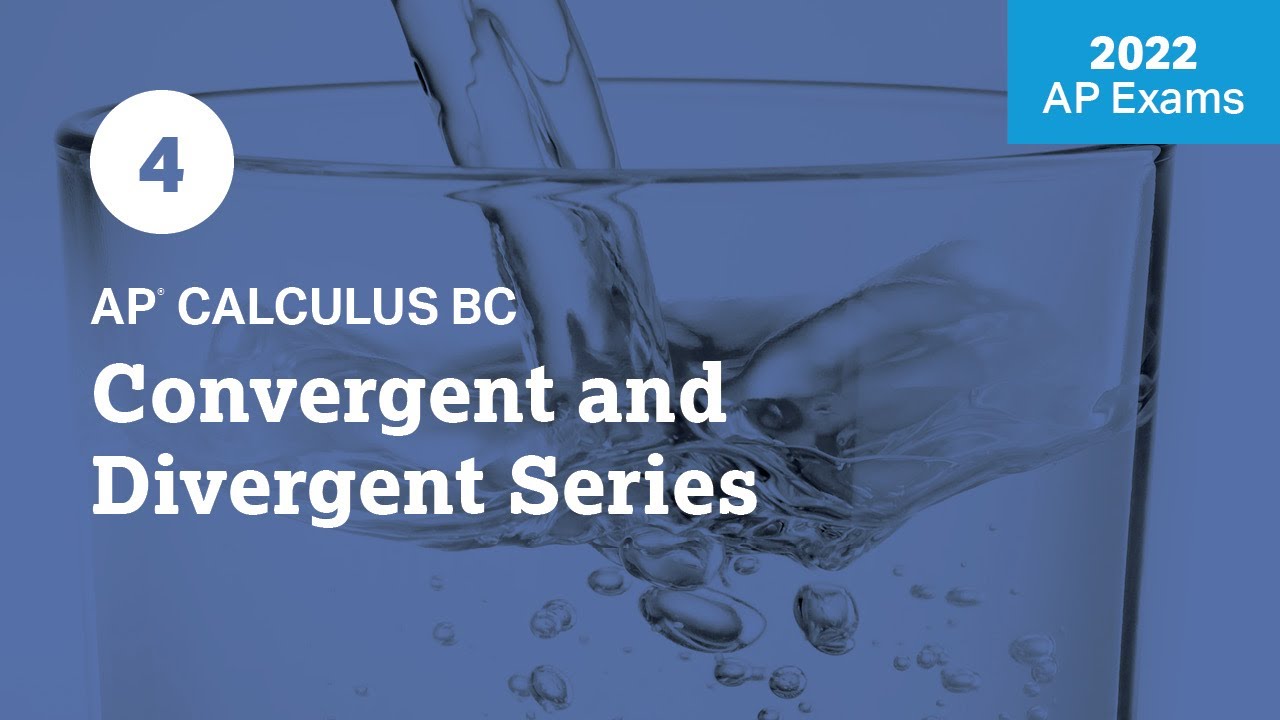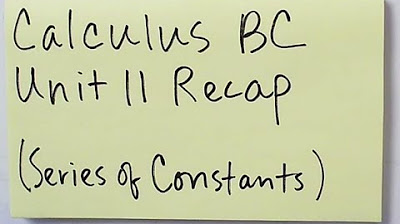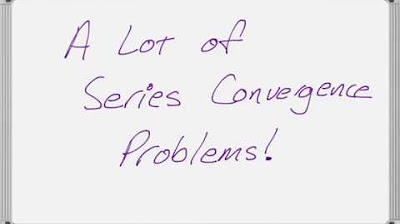Monday Night Calculus: Strategy for testing series
TLDRIn this engaging and informative session, Curtis Brown is joined by Steve Kakaska and Tom Dick to discuss various calculus topics, focusing on series convergence and divergence. The trio delves into different tests for determining the convergence of series, such as the ratio test, integral test, and alternating series test. They also address common mistakes made by students on the AP Calculus exam and provide valuable insights on how to approach exam preparation effectively. The session is filled with practical examples and strategies, aiming to enhance students' understanding and problem-solving skills in calculus.
Takeaways
- 📘 The importance of understanding convergence and divergence in series, and the various tests (p-series, geometric series, limit comparison test, etc.) to determine them.
- 🔍 The lack of definitive rules for choosing which test to apply, emphasizing the need for practice and pattern recognition in problem-solving.
- 📈 The significance of the nth term test for divergence, where the limit of the nth term being non-zero indicates a divergent series.
- 📊 The application of the integral test for series involving functions that are positive, continuous, and decreasing on the given interval.
- 🔄 The discussion on the alternating series test, including its two conditions and the importance of the monotonic condition for the series to converge.
- 🤔 The consideration of factorials in series and how the ratio test can be particularly useful for these cases, such as in Taylor series.
- 📱 The use of technology, like the TI-84 calculator, to visually explore and approximate series through sequence plots.
- 🚀 The efficiency of recursively defining sequence values on calculators to speed up graphing and better understand series convergence.
- 🎯 The upcoming focus on AP Calculus exam preparation, highlighting common errors and effective calculator strategies.
- 🙏 Encouragement for students to participate in the next session for valuable insights on test preparation and strategies.
- 👋 An expression of gratitude for the collaboration and the opportunity to delve into calculus topics throughout the series.
Q & A
What is the main topic of the transcript?
-The main topic of the transcript is a discussion on calculus, specifically focusing on series and their convergence or divergence.
Who are the hosts and guests in the transcript?
-The host of the discussion is Curtis Brown, and he is joined by Steve Kakaska and Tom Dick as guests.
What is the significance of the upcoming Monday night calculus session mentioned in the transcript?
-The upcoming Monday night calculus session is significant because it will be the last one of the season, focusing on preparing for the AP calculus exams.
What is the ratio test used for in the context of series?
-The ratio test is used to determine the convergence or divergence of a series. It involves comparing the limit of the ratio of consecutive terms to a certain value that indicates the behavior of the series.
What is the integral test mentioned in the transcript?
-The integral test is a method used to determine the convergence of a series. It involves comparing the series to the integral of a related function and evaluating the improper integral to determine if the series converges or diverges.
What is the alternating series test and what are its two conditions?
-The alternating series test is a method to determine the convergence of an alternating series. The two conditions are that the limit of the terms as n approaches infinity must be zero, and the terms must be decreasing in absolute value.
What is the significance of the nth term test in the transcript?
-The nth term test, also known as the test for divergence, involves examining the limit of the nth term of a series as n approaches infinity. If the limit is not zero, the series diverges.
What is the limit comparison test and how is it applied in the transcript?
-The limit comparison test is a method to determine the convergence of a series by comparing it to another known series. In the transcript, it is applied by comparing the limit of the ratio of the terms of the series being tested to a known converging or diverging series.
What is the significance of the geometric series mentioned in the transcript?
-The geometric series is a type of series where each term is a constant multiple of the previous term. In the transcript, it is used as a reference point for comparison when discussing the convergence of other series.
What is the role of the computer algebra system in the discussion about series?
-The computer algebra system is used to illustrate the behavior of certain series, such as the harmonic series and p-series. It provides a tool for exploring and visualizing the convergence or divergence of these series.
How does the transcript emphasize the importance of understanding convergence tests?
-The transcript emphasizes the importance of understanding convergence tests by discussing various tests and their applications. It highlights how these tests can help determine the behavior of a series and provide insights into whether it converges or diverges.
Outlines
🎓 Introduction to Monday Night Calculus
The video begins with Curtis Brown introducing the Monday Night Calculus session, welcoming viewers to the program. He is joined by Steve Kakaska and Tom Dick, who will be sharing their expertise in calculus and teaching about calculators. Curtis also announces that there will be an off-cycle session next week focused on preparing for the upcoming AP exams, and encourages students to participate. The hosts express gratitude for the support they've received and mention some positive feedback from the community.
📚 Series Convergence and Divergence Tests
The discussion shifts to series convergence and divergence tests. The speakers cover various methods such as the p-series, geometric series, comparison tests, and the nth term test. They emphasize the importance of practice in developing a good understanding of calculus and problem-solving skills. The conversation also touches on the challenges of choosing the right test for a given series and the need for pattern recognition in solving calculus problems.
🧐 Analyzing Specific Series Examples
The hosts delve into specific examples of series, discussing how to identify their form and apply appropriate tests. They explore series that resemble p-series or geometric series and how to use the limit comparison test. The conversation also includes a question about what happens if the limit of the nth term of a series is zero, highlighting the importance of understanding the implications of such results.
🤔 Deep Dive into Convergence Tests
The conversation continues with a deeper exploration of convergence tests, including the integral test and the alternating series test. The hosts discuss the conditions that must be met for these tests to be applicable and what can be concluded if these conditions are not met. They also address the ratio test and its significance in determining the convergence of series involving factorials or polynomial functions.
📈 Visualizing Series Convergence with Technology
Tom shares his screen to discuss the use of technology in visualizing series convergence. He talks about the sequence plotter on the TI-84 calculator and how it can be used to graph the partial sums of a series, providing a visual representation of convergence. The discussion includes tips on how to make the most of the calculator's capabilities and the importance of understanding the limitations of graphical evidence in determining the convergence of a series.
🚀 Taylor Series and Polynomials
The conversation turns to Taylor series and polynomials. The hosts explore what happens when a Taylor polynomial is used to approximate a function that is already a polynomial. They discuss the concept of expanding a polynomial around different points and how this affects the fit of the approximation. The discussion also touches on the Lagrange error and the importance of the ratio test in determining the radius of convergence for Taylor series.
🎯 Preparing for the AP Calculus Exam
As the session comes to a close, the hosts remind viewers about the upcoming AP Calculus exam preparation session. They emphasize the importance of the exam and encourage students to participate actively. The hosts also share some final thoughts on the series topics discussed throughout the session, highlighting the key points and providing a brief overview of the strategies and tips that were covered.
Mindmap
Keywords
💡Calculus
💡Series Convergence
💡p-Series
💡Geometric Series
💡Limit Comparison Test
💡Alternating Series Test
💡Integral Test
💡Ratio Test
💡Taylor Series
💡TI-84 Calculator
Highlights
Introduction to the Monday Night Calculus series and the hosts Curtis Brown, Steve Kakaska, and Tom Dick.
Announcement of a special off-cycle Monday Night Calculus session focused on AP exam preparation.
Discussion on the importance of practice and developing problem-solving skills in calculus.
Overview of different tests for series convergence and divergence, including p-series and geometric series tests.
Explanation of the comparison test for series and how to apply it to determine convergence or divergence.
Discussion on the integral test and its application to series involving factorials or powers of n.
Clarification on the conditions for the alternating series test and the implications if one condition is not met.
Presentation of the ratio test for series and its particular usefulness for series involving factorials.
Explanation of the root test and its use in series convergence testing.
Discussion on the importance of checking for monotonicity in the alternating series test and the consequences of ignoring this condition.
Illustration of the Taylor series and polynomials, and the significance of the ratio test in determining the radius of convergence.
Demonstration of how to use the TI-84 calculator for exploring series through sequence plotting.
Explanation of the efficient method for summing sequences on the TI-84 by using recursive definitions.
Discussion on the graphical evidence of series convergence and how it approximates to the sum of the series.
Highlight of the upcoming Monday Night Calculus session focused on test preparation for the AP Calculus exam.
Acknowledgment of the contributions and efforts of the hosts and the importance of the series covered in the session.
Encouragement for students to participate in the next Monday Night Calculus session for AP exam preparation.
Transcripts
Browse More Related Video
5.0 / 5 (0 votes)
Thanks for rating:





